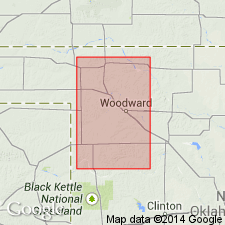
- Usage in publication:
-
- Relay Creek dolomite
- Modifications:
-
- Original reference
- Dominant lithology:
-
- Dolomite
- AAPG geologic province:
-
- Anadarko basin
Summary:
Pg. 405-432. Relay Creek dolomite. The dolomites at or near top of Marlow member of Whitehorse formation have been known as "Greenfield" dolomites, but this name is preoccupied, and it seems well to offer a new name. The name Relay Creek is suggested for these beds, from exposures both north and south of Relay Creek, in T. 15 N., R. 12 W., and adjoining townships on south and east, [Blaine County, northwestern Oklahoma]. There are ordinarily 2 beds of dolomite separated by approximately 25 feet of red sandstone and shale. Each bed is 1 or 2 feet thick, but in other areas the thickness decreases to almost nothing. Locally there is a third bed of dolomite 7 or 8 feet below the lower of the two. The 2 beds commonly occurring are here designated Upper Relay Creek dolomite and Lower Relay Creek dolomite. The third or lowest bed is associated so closely with Lower Relay Creek dolomite that it is merely mentioned, with no distinguishing name. Color of these dolomites varies from light gray, where the beds are 1 or 2 feet thick, to almost black, where the beds are very thin. In type area, where thickness is almost maximum, the color is gray. Age is Permian.
[See also under Day Creek dolomite.]
Source: US geologic names lexicon (USGS Bull. 896, p. 1795).
For more information, please contact Nancy Stamm, Geologic Names Committee Secretary.
Asterisk (*) indicates published by U.S. Geological Survey authors.
"No current usage" (†) implies that a name has been abandoned or has fallen into disuse. Former usage and, if known, replacement name given in parentheses ( ).
Slash (/) indicates name conflicts with nomenclatural guidelines (CSN, 1933; ACSN, 1961, 1970; NACSN, 1983, 2005, 2021). May be explained within brackets ([ ]).

